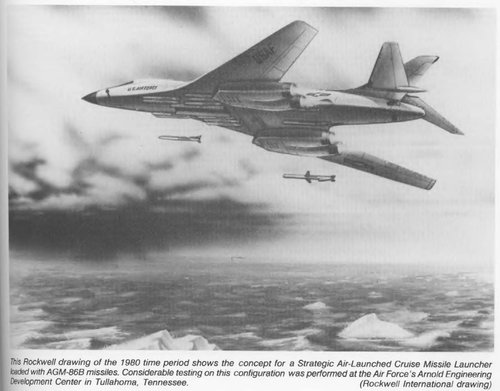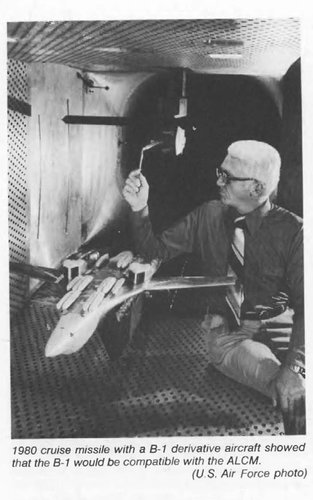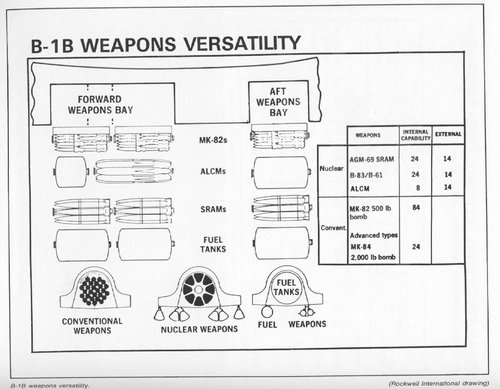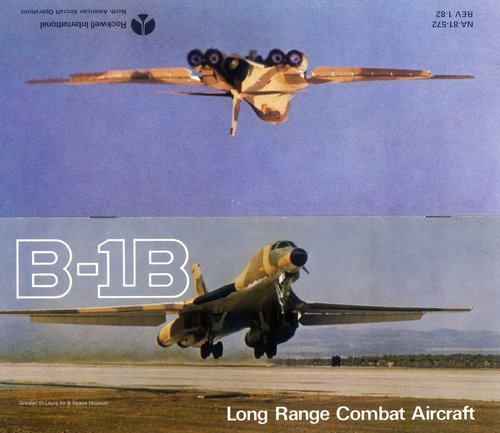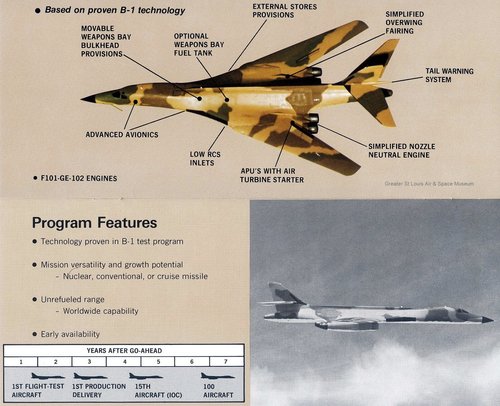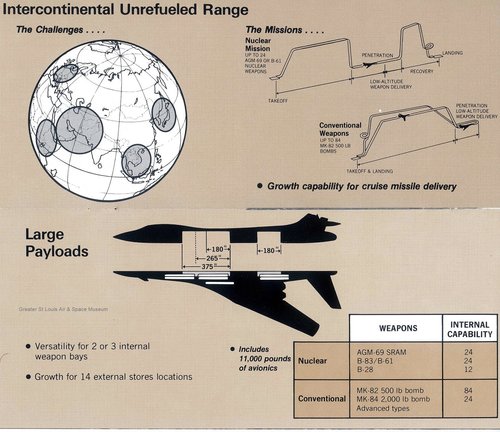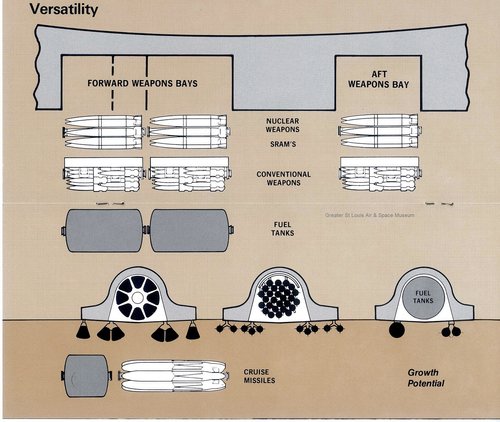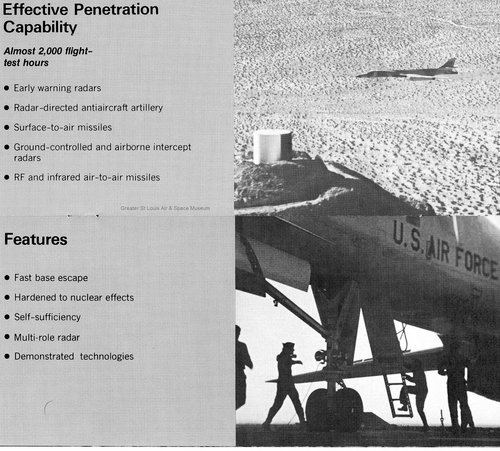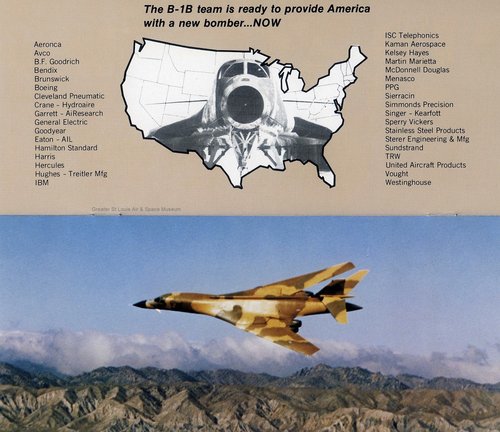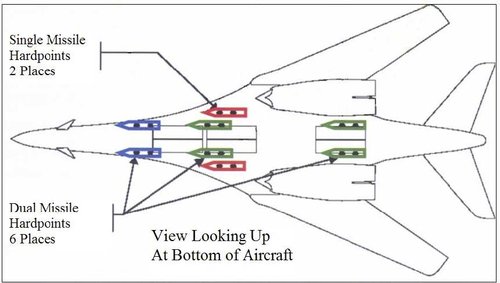You are using an out of date browser. It may not display this or other websites correctly.
You should upgrade or use an alternative browser.
You should upgrade or use an alternative browser.
North American Rockwell / Boeing B-1 Lancer
- Thread starter flateric
- Start date
-
- Tags
- air force global strike command boeing bomber cold war cold war ii early 21st century late 20th century north american aviation north american rockwell nuclear battlefield post-cold war rockwell international strategic air command strategic bomber supersonic united states air force united states navy
Bhurki
ACCESS: Secret
- Joined
- 16 July 2020
- Messages
- 345
- Reaction score
- 379
The model art most likely represents Agm-86.
Loadout for Agm 86B on B-1b prior to Salt2 -
Fwd - 2x(2)
Int - 2x(2) main station + 2x(1) abreast station
Aft - 2x(2)
marauder2048
"I should really just relax"
- Joined
- 19 November 2013
- Messages
- 3,157
- Reaction score
- 911
I think that makes way more sense than destroying production lines. Keep the line, even if nothing is being produced (although ideally you should have some minimal production to keep the supply and spares lines intact), until a replacement is in production. That way if there is an emergency you can build something rather than having no options. Witness the C-17 and F-22 debacles, with lines destroyed and then - hey, we could use some more of those.We could see something similar on the other shore of Atlaintic ocean (Pacific as well) - Russia restore production of Tu-160 Blackjacs after decades of launching the last (Soviet-time) example. I'm sure that's not an easy task, though...
Difference is the line never went anywhere. It just collected dust. Big difference.
It's not the production line that withers it's the supply chain. They have all of the tooling for the B-1B and the F-22. (don't know about the C-17).
In the B-1B case, they have had to build a new 47.5 ft long center longeron with that tooling; thankfully the boron/expoxy
material supplier was still in business and still producing the same material.
For the F-22, the workforce and supply chain that built it is now busy building other things
Forest Green
ACCESS: Above Top Secret
- Joined
- 11 June 2019
- Messages
- 7,705
- Reaction score
- 12,905
He's right, the B1-B is stated to have been capable of carrying 14 AGM-86Bs externally.Those are the two station pylons. The two single pylons aren't attached.
There are smarter people than myself here but the bone never did because of aerodynamicsHe's right, the B1-B is stated to have been capable of carrying 14 AGM-86Bs externally.Those are the two station pylons. The two single pylons aren't attached.
Forest Green
ACCESS: Above Top Secret
- Joined
- 11 June 2019
- Messages
- 7,705
- Reaction score
- 12,905
It didn't because of a Treaty, which also affected the Tu-160.There are smarter people than myself here but the bone never did because of aerodynamics
- Joined
- 1 April 2006
- Messages
- 11,017
- Reaction score
- 8,307
fromHe's right, the B1-B is stated to have been capable of carrying 14 AGM-86Bs externally.
Aero Series 35 - The B-1 Bomber by Bill Holder
TAB Books / Aero Publishers (1988)
Attachments
- Joined
- 3 June 2011
- Messages
- 17,867
- Reaction score
- 10,892
There are smarter people than myself here but the bone never did because of aerodynamicsHe's right, the B1-B is stated to have been capable of carrying 14 AGM-86Bs externally.Those are the two station pylons. The two single pylons aren't attached.
Evidence? Aside from being forbidden by Treaty (which would be unnecessary if external carriage were impossible) I've never seen any such information. I also read somewhere that the AGM-129 was designed for supersonic EXTERNAL carriage, and the B-52 damn sure wouldn't be doing that.
The acoustics under the B-1B are -terrible- with high pressure vortices flows that curl up around the glove root and beat the skin with something like 170 decibels of constant thumping. Tore the AGM-86 to pieces. The AGM-129 was designed to handle the aeros environment but the drag on the jet became so bad that it could neither make range nor refuel at a safe height
The 1B would probably run out of fuel trying to dash supersonic with all that drag...
The 1B would probably run out of fuel trying to dash supersonic with all that drag...
Last edited:
Bhurki
ACCESS: Secret
- Joined
- 16 July 2020
- Messages
- 345
- Reaction score
- 379
Thanks for confirming. Its 14.
Also second row of graphics show how the bulkhead is moved forward to fit the hypersonic missiles (ALCM in the graphic)
So, a total of 10-12 ARRW could be mounted (6 external+ 4-6 internal (?))
Could it even fit on the existing AF rotary launcher, if yes, whats its weight limit?
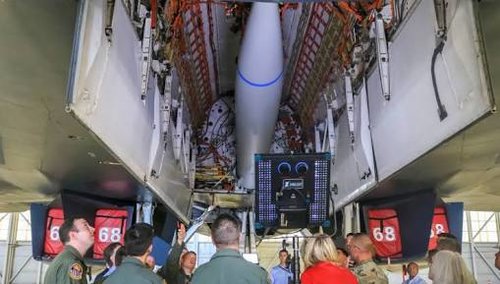
Last edited:
Thanks for confirming. Its 14.
Also second row of graphics show how the bulkhead is moved forward to fit the hypersonic missiles (ALCM in the graphic)
So, a total of 10-12 ARRW could be mounted (6 external+ 4-6 internal (?))
Could it even fit on the existing AF rotary launcher, if yes, whats its weight limit?
View attachment 640902
Forward bulkhead position, 8 AGM-186B at 3,150 lbs a piece comes to 25,200 lbs. My guess though is clearance will be the limiting factor, if GBU-31's already have clearance issues then the much larger ARRW will be worse.
- Joined
- 3 June 2011
- Messages
- 17,867
- Reaction score
- 10,892
The acoustics under the B-1B are -terrible- with high pressure vortices flows that curl up around the glove root and beat the skin with something like 170 decibels of constant thumping. Tore the AGM-86 to pieces. The AGM-129 was designed to handle the aeros environment but the drag on the jet became so bad that it could neither make range nor refuel at a safe height
The 1B would probably run out of fuel trying to dash supersonic with all that drag...
Still waiting for a source.
The acoustics under the B-1B are -terrible- with high pressure vortices flows that curl up around the glove root and beat the skin with something like 170 decibels of constant thumping. Tore the AGM-86 to pieces. The AGM-129 was designed to handle the aeros environment but the drag on the jet became so bad that it could neither make range nor refuel at a safe height
The 1B would probably run out of fuel trying to dash supersonic with all that drag...
Still waiting for a source.
Probably not going to get one. Everything forward of the nacelles was pretty benign, the flow aft of the nacelles was pretty challenging. If we had problems with a separation test on the Bone chances were it was an aft bay test. Got to see some pretty interesting video back in the day of aft bay tests...
- Joined
- 3 June 2011
- Messages
- 17,867
- Reaction score
- 10,892
The acoustics under the B-1B are -terrible- with high pressure vortices flows that curl up around the glove root and beat the skin with something like 170 decibels of constant thumping. Tore the AGM-86 to pieces. The AGM-129 was designed to handle the aeros environment but the drag on the jet became so bad that it could neither make range nor refuel at a safe height
The 1B would probably run out of fuel trying to dash supersonic with all that drag...
Still waiting for a source.
Probably not going to get one. Everything forward of the nacelles was pretty benign, the flow aft of the nacelles was pretty challenging. If we had problems with a separation test on the Bone chances were it was an aft bay test. Got to see some pretty interesting video back in the day of aft bay tests...
I could see air getting all jammed up with 6 abreast as well as the 2 nacelles. Maybe that's why they're sticking to in-line only, and going with bigger weapons.
The acoustics under the B-1B are -terrible- with high pressure vortices flows that curl up around the glove root and beat the skin with something like 170 decibels of constant thumping. Tore the AGM-86 to pieces. The AGM-129 was designed to handle the aeros environment but the drag on the jet became so bad that it could neither make range nor refuel at a safe height
The 1B would probably run out of fuel trying to dash supersonic with all that drag...
Still waiting for a source.
Probably not going to get one. Everything forward of the nacelles was pretty benign, the flow aft of the nacelles was pretty challenging. If we had problems with a separation test on the Bone chances were it was an aft bay test. Got to see some pretty interesting video back in the day of aft bay tests...
I could see air getting all jammed up with 6 abreast as well as the 2 nacelles. Maybe that's why they're sticking to in-line only, and going with bigger weapons.
We got the dirty air with nothing on the pylons. The test accel. to field Sniper paid a lot of attention to safe separation. The final mission, which I was the test conductor, was a GBU-31 out of the aft bay at .94M and 1,500 ft AGL. It came out clean and the rest is history. If everything were so easy...
- Joined
- 1 November 2009
- Messages
- 638
- Reaction score
- 408
sferrin, you wil find some information in this document. The rest is gleaned from memory in documents and interviews probably no longer found online.The acoustics under the B-1B are -terrible- with high pressure vortices flows that curl up around the glove root and beat the skin with something like 170 decibels of constant thumping. Tore the AGM-86 to pieces. The AGM-129 was designed to handle the aeros environment but the drag on the jet became so bad that it could neither make range nor refuel at a safe height
The 1B would probably run out of fuel trying to dash supersonic with all that drag...
Still waiting for a source.
sferrin, you wil find some information in this document. The rest is gleaned from memory in documents and interviews probably no longer found online.The acoustics under the B-1B are -terrible- with high pressure vortices flows that curl up around the glove root and beat the skin with something like 170 decibels of constant thumping. Tore the AGM-86 to pieces. The AGM-129 was designed to handle the aeros environment but the drag on the jet became so bad that it could neither make range nor refuel at a safe height
The 1B would probably run out of fuel trying to dash supersonic with all that drag...
Still waiting for a source.
Good find Rooster, the info is on page 37. The high acoustics were high speed and low level 165 dB. Not surprisingly aft stations the worst, downstream of the tunnel right next to 4 exhaust nozzles.
- Joined
- 3 June 2011
- Messages
- 17,867
- Reaction score
- 10,892
Thank you!sferrin, you wil find some information in this document. The rest is gleaned from memory in documents and interviews probably no longer found online.The acoustics under the B-1B are -terrible- with high pressure vortices flows that curl up around the glove root and beat the skin with something like 170 decibels of constant thumping. Tore the AGM-86 to pieces. The AGM-129 was designed to handle the aeros environment but the drag on the jet became so bad that it could neither make range nor refuel at a safe height
The 1B would probably run out of fuel trying to dash supersonic with all that drag...
Still waiting for a source.
aonestudio
I really should change my personal text
- Joined
- 11 March 2018
- Messages
- 2,847
- Reaction score
- 7,000
- Joined
- 3 June 2011
- Messages
- 17,867
- Reaction score
- 10,892
Shouldn't this go on the fan art page?
Last edited:
aonestudio
I really should change my personal text
- Joined
- 11 March 2018
- Messages
- 2,847
- Reaction score
- 7,000
B-1B Integrated Battle Station modification completed
An eight-year project to install the Integrated Battle Station on the B-1B Lancer fleet has been completed ahead of schedule. Sixty aircraft went through the modification process that began in late
www.hill.af.mil
FighterJock
ACCESS: Top Secret
- Joined
- 29 October 2007
- Messages
- 4,914
- Reaction score
- 4,683
Shouldn't this go on the fan art page?
That is fast for a bomb drop, 41.2 seconds, especially for the bombs to be the Small Diameter Bombs. Another thing were they dropped onto separate targets?
- Joined
- 3 June 2011
- Messages
- 17,867
- Reaction score
- 10,892
Shouldn't this go on the fan art page?
That is fast for a bomb drop, 41.2 seconds, especially for the bombs to be the Small Diameter Bombs. Another thing were they dropped onto separate targets?
The time and being on separate targets isn't beyond belief. It's just that I think it might be fan art, It definitely isn't a real video.
FighterJock
ACCESS: Top Secret
- Joined
- 29 October 2007
- Messages
- 4,914
- Reaction score
- 4,683
Shouldn't this go on the fan art page?
That is fast for a bomb drop, 41.2 seconds, especially for the bombs to be the Small Diameter Bombs. Another thing were they dropped onto separate targets?
The time and being on separate targets isn't beyond belief. It's just that I think it might be fan art, It definitely isn't a real video.
Taken in by fan art yet again. Damn it. Thanks sferrin. Got to be extra careful with those people doing fan art these day's.
Is there any plan to integrate the SDB with any bomber? Seems odd they wouldn't be given a more cost effective stand off capability than AGM-158.
- Joined
- 21 April 2009
- Messages
- 13,549
- Reaction score
- 7,135
Heavy bombers married to PGMs is just an awesome warfighter overmatch and a real strategic conventional deterrent.
US should continue to support a large robust bomber force of high-low super stealthy / bomb truck / arsenal plane force.
US should continue to support a large robust bomber force of high-low super stealthy / bomb truck / arsenal plane force.
- Joined
- 21 April 2009
- Messages
- 13,549
- Reaction score
- 7,135

Making Bones: Air Force to develop ‘digital twin’ of B-1 for damage prediction
Digital aircraft replicas may make maintenance faster, more effective and help forecast potential problems.
- Joined
- 16 April 2008
- Messages
- 9,003
- Reaction score
- 12,658
I think the external ordnance had to be released before the bomb bays had clearance.
Not necessarily. The bay doors can open part way with the ACM pylons in place, enough to drop a single weapon off a rotary launcher, but not bombs from the Conventional Weapons Module. See pics here:
I have a hard time believing anything could come out of the back two bomb bays in the configuration. Everything I've heard is that the turbulence between the nacelles gets really bad. I read once that the B-1 was limited to just sixteen Mk82 (500#) JDAMs and when I actually found a guy who claimed to be a B-1Nav named Calvin, he confirmed. I asked him about that; he said that to drop that size bomb they had to use the same rack as the CBU-87s (10x per bay) but that ordnance had separation issues - the front bay could carry the full ten, but the next one only four, and the back bay only two, for the total that I'd read of sixteen. I assume something about the aerodynamics or weight of TMDs allowed for the full number to be carried. But point being, that's rough air and I doubt lining the area around the bomb bays with draggy pylons and 3000lb missiles is going to smooth it out.
Academic I think, because no one is investing any time or money getting the externals operational (outside the SNIPER pod) on the small number of tired aircraft that are combat coded. B-1 is I think the first platform due to be replaced by B-21 now.
Academic I think, because no one is investing any time or money getting the externals operational (outside the SNIPER pod) on the small number of tired aircraft that are combat coded. B-1 is I think the first platform due to be replaced by B-21 now.
- Joined
- 3 June 2011
- Messages
- 17,867
- Reaction score
- 10,892
Academic I think, because no one is investing any time or money getting the externals operational (outside the SNIPER pod) on the small number of tired aircraft that are combat coded. B-1 is I think the first platform due to be replaced by B-21 now.
Yeah, that's not true. Go to the previous page and the top of this one.
Not seeing anything that contradicts my post.Academic I think, because no one is investing any time or money getting the externals operational (outside the SNIPER pod) on the small number of tired aircraft that are combat coded. B-1 is I think the first platform due to be replaced by B-21 now.
Yeah, that's not true. Go to the previous page and the top of this one.
- Joined
- 3 June 2011
- Messages
- 17,867
- Reaction score
- 10,892
"You can lead a horse to water..."Not seeing anything that contradicts my post.Academic I think, because no one is investing any time or money getting the externals operational (outside the SNIPER pod) on the small number of tired aircraft that are combat coded. B-1 is I think the first platform due to be replaced by B-21 now.
Yeah, that's not true. Go to the previous page and the top of this one.
I have a hard time believing anything could come out of the back two bomb bays in the configuration. Everything I've heard is that the turbulence between the nacelles gets really bad. I read once that the B-1 was limited to just sixteen Mk82 (500#) JDAMs and when I actually found a guy who claimed to be a B-1Nav named Calvin, he confirmed. I asked him about that; he said that to drop that size bomb they had to use the same rack as the CBU-87s (10x per bay) but that ordnance had separation issues - the front bay could carry the full ten, but the next one only four, and the back bay only two, for the total that I'd read of sixteen. I assume something about the aerodynamics or weight of TMDs allowed for the full number to be carried. But point being, that's rough air and I doubt lining the area around the bomb bays with draggy pylons and 3000lb missiles is going to smooth it out.
Academic I think, because no one is investing any time or money getting the externals operational (outside the SNIPER pod) on the small number of tired aircraft that are combat coded. B-1 is I think the first platform due to be replaced by B-21 now.
Yes, Calvin from the old RAM days...Back in the day we were both at Dyess at the same time. When GBU-38 first arrived on the scene you are correct it could only be carried in the 10 bys since they were the only 1760 enabled bys with 14 inch lugs. Granted it's been over 15 years, so memory is faded, but fin clearance was the limiting issue for number of GBU-38's in a 10 by as they were intended for CBU's. I forget the total number carried but it was less than 10. The air was clean for the front two bays, but you are correct the rear bay couldn't drop GBU-38 at least up until 2008-9 when I finally left bombers. FWIW I've actually seen some of the GBU-38 separation videos, it isn't so much that the bomb separates unsafe, like a certain configuration on the BUFF where GBU-12 from the bay came back and hit the aircraft, but that it causes the weapon to be ineffective.
Well after I left, they added GBU-38 to the rotaries, two for every 30 inch lug. With the demise of CBU's not even sure if the 10 bys are still around these days. Don't get me started on the 28's...
Thanks for the info! I perhaps incorrectly remembered the GBU-38 discussion I had with Calvin; it was years ago. Wish him well if you are in contact; I met him on TankNet but haven't seen him there for a year or so.
Similar threads
-
AMSA Program & B-1 Bomber projects
- Started by overscan (PaulMM)
- Replies: 172
-
-
-
North American 'Retaliator' & NR-349 Interceptor proposals
- Started by Pioneer
- Replies: 77
-

